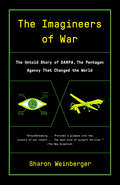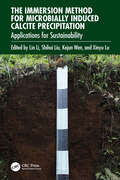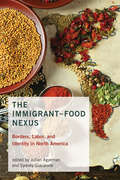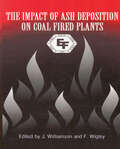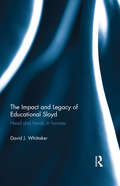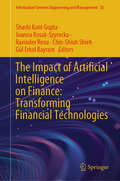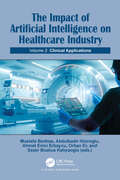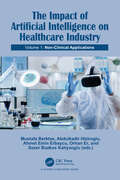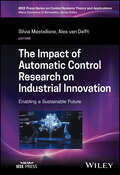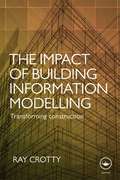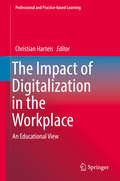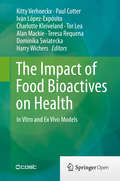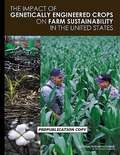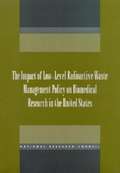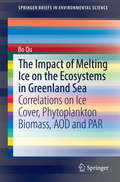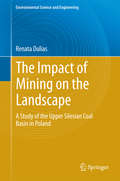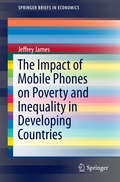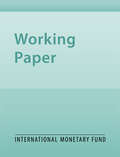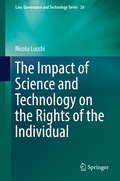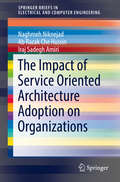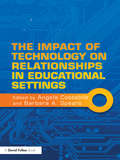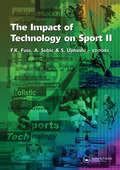- Table View
- List View
The Imagineers of War: The Untold Story of DARPA, the Pentagon Agency That Changed the World
by Sharon WeinbergerThe definitive history of the Defense Advanced Research Projects Agency, the Pentagon agency that has quietly shaped war and technology for nearly sixty years.Founded in 1958 in response to the launch of Sputnik, the agency’s original mission was to create “the unimagined weapons of the future.” Over the decades, DARPA has been responsible for countless inventions and technologies that extend well beyond military technology. Sharon Weinberger gives us a riveting account of DARPA’s successes and failures, its remarkable innovations, and its wild-eyed schemes. We see how the threat of nuclear Armageddon sparked investment in computer networking, leading to the Internet, as well as to a proposal to power a missile-destroying particle beam by draining the Great Lakes. We learn how DARPA was responsible during the Vietnam War for both Agent Orange and the development of the world’s first armed drones, and how after 9/11 the agency sparked a national controversy over surveillance with its data-mining research. And we see how DARPA’s success with self-driving cars was followed by disappointing contributions to the Afghanistan and Iraq wars.Weinberger has interviewed more than one hundred former Pentagon officials and scientists involved in DARPA’s projects—many of whom have never spoken publicly about their work with the agency—and pored over countless declassified records from archives around the country, documents obtained under the Freedom of Information Act, and exclusive materials provided by sources. The Imagineers of War is a compelling and groundbreaking history in which science, technology, and politics collide.
The Immersion Method for Microbially Induced Calcite Precipitation: Applications for Sustainability
by Lin Li Xinyu Lu Shihui Liu Kejun WenThe Immersion Method for Microbially Induced Calcite Precipitation: Applications for Sustainability comprehensively explores the synergy between microbiology and engineering, focusing on MICP and its applications in material improvement and environmental remediation. Highlighting the immersion method, the book elucidates MICP's ability to enhance mechanical properties uniformly throughout treated materials, offering a sustainable alternative for various engineering challenges. Emphasizing its applications in civil engineering and environmental management, the book showcases MICP's efficacy in ground improvement, crack repair, and soil stabilization, alongside its potential for mitigating environmental contamination. Examines the potential to create environmentally sustainable and resilient construction materials. Discusses various applications of MICP across critical areas of civil engineering and environmental management, including ground improvement, crack repair, and remediation of contaminated environments. Provides a detailed examination of MICP-treated materials’ long-term durability and performance under various environmental conditions.
The Immigrant-Food Nexus: Borders, Labor, and Identity in North America (Food, Health, and the Environment)
by Julian Agyeman Sydney GiacaloneThe intersection of food and immigration in North America, from the macroscale of national policy to the microscale of immigrants' lived, daily foodways.This volume considers the intersection of food and immigration at both the macroscale of national policy and the microscale of immigrant foodways—the intimate, daily performances of identity, culture, and community through food. Taken together, the chapters—which range from an account of the militarization of the agricultural borderlands of Yuma, Arizona, to a case study of Food Policy Council in Vancouver, Canada—demonstrate not only that we cannot talk about immigration without talking about food but also that we cannot talk about food without talking about immigration.The book investigates these questions through the construct of the immigrant-food nexus, which encompasses the constantly shifting relationships of food systems, immigration policy, and immigrant foodways. The contributors, many of whom are members of the immigrant communities they study, write from a range of disciplines. Three guiding themes organize the chapters: borders—cultural, physical, and geopolitical; labor, connecting agribusiness and immigrant lived experience; and identity narratives and politics, from “local food” to “dietary acculturation.”ContributorsJulian Agyeman, Alison Hope Alkon, FernandoJ. Bosco, Kimberley Curtis, Katherine Dentzman, Colin Dring, Sydney Giacalone, Sarah D. Huang, Maryam Khojasteh, Jillian Linton, Pascale Joassart-Marcelli, Samuel C. H. Mindes, Laura-Anne Minkoff-Zern, Christopher Neubert, Fabiola Ortiz Valdez, Victoria Ostenso, Catarina Passidomo, Mary Beth Schmid, Sea Sloat, Kat Vang, Hannah Wittman, Sarah Wood
The Immortalists: Charles Lindbergh, Dr. Alexis Carrel, and Their Daring Quest to Live Forever
by David M. FriedmanHis historic career as an aviator made Charles Lindbergh one of the most famous men of the twentieth century, the subject of best-selling biographies and a hit movie, as well as the inspiration for a dance step—the Lindy Hop—that he himself was too shy to try. But for all the attention lavished on Lindbergh, one story has remained untold until now: his macabre scientific collaboration with Dr. Alexis Carrel. This oddest of couples—one a brilliant Nobel Prize-winning surgeon turned social engineer, the other a failed dirt farmer turned hero of the skies—joined forces in 1930 driven by a shared and secret dream: to conquer death and attain immortality.Part Frankenstein, part The Professor and the Madman, and all true, The Immortalists is the remarkable story of how two men of prodigious achievement and equally large character flaws challenged nature's oldest rule, with consequences—personal, professional, and political—that neither man anticipated.
The Impact Of Ash Deposition On Coal Fired Plants: Proceedings of the Engineering Foundation Conference Held at the St. John's Swallow Hotel, Solihull, England
by Jim WilliamsonCoal provides almost 40% of the world's electricity, and despite the understandable concern with respect to the environmental impact associated with coal use, forecasts from the International Energy Agency predict, that worldwide coal use will increase by up to 2% per annum until the year 2OlO. Faced with this increase, it is clearly important that the most efficient and environmentally acceptable clean coal technologies are available. This book is comprised of the proceedings of the Engineering Foundation Conference held in June 1993 in England. The objective of the conference was to present ideas on methods of predicting and reducing the effects of ash deposition in coal conversion systems, highlighting the problems experienced in industry, considering both utilities and industrial plants, and providing a view of the technology of coal ash deposition and its impact. Better techniques are needed to reduce the impact of ash deposition in coal fired plants, and these proceedings should form a reference document for anyone either experiencing slagging or actively engaged in trying to understand or eliminate the phenomenon.
The Impact and Legacy of Educational Sloyd: Head and hands in harness
by David J. WhittakerOriginating in Finland in eighteen-sixty-five, Educational Sloyd used handicrafts practised in schools to promote educational completeness through the interdependence of the mind and body. These radical ideas spread throughout Europe and America and had a significant impact on the early development of manual training, manual arts, industrial education and technical education. Today it is generally acknowledged that Educational Sloyd laid the foundations of modern technological education. This book traces the development of Sloyd from its conception by Uno Cygnaeus and the first Sloyd school founded by Otto Salomon, to its enthusiastic take up in Scandinavia and beyond. It examines the debates and controversy which surround the Sloyd system, and considers the transition from ‘hands-on’ craft work to concepts of technology education. Finally, the investigation reveals the lasting legacy of the ideas and practice of Sloyd education, and how it continues to influence technological education. Included in the book: - the foundations of Educational Sloyd - debates, controversy and rival factions - key case studies in Finland and Iceland - the lasting legacy of Sloyd education. This fascinating and comprehensive historical exploration will be of interest to scholars and researchers in the areas of technology education, comparative education and the history of education.
The Impact of Artificial Intelligence on Finance: Transforming Financial Technologies (Information Systems Engineering and Management #53)
by Gül Erkol Bayram Joanna Rosak-Szyrocka Shashi Kant Gupta Chin-Shiuh Shieh Ravinder RenaThis book discovers how artificial intelligence is revolutionizing the financial sector with cutting-edge insights and practical applications. This book delves into the transformative power of AI, exploring its role in enhancing customer experiences, improving security, and driving predictive analytics. By integrating emerging technologies like blockchain and quantum computing, it offers a comprehensive view of the future of finance. The book's innovative approach provides a deep dive into AI's impact on financial decision-making, fraud detection, and risk assessment. Designed for finance professionals, academics, and tech enthusiasts, it serves as a vital resource for understanding and leveraging AI in finance. Key uses include strategic planning, technology adoption, and enhancing operational efficiency in financial services.
The Impact of Artificial Intelligence on Health Industry: Volume 2: Clinical Applications
by Sezer Bozkus Kahyaoglu Mustafa Berktas Abdulkadir Hiziroglu Ahmet Emin Erbaycu Orhan ErThe healthcare sector is highly dependent on technological innovations, much more than most other industries. The positive side is the potential to implement these technological innovations for major improvements and benefits. There has been a significant increase in the use of artificial intelligence techniques in clinical and non-clinical areas in healthcare. The chapters in this book are presented by professionals who are experts in healthcare and have academic experience. The aim of this volume is to add to the literature and to present the current state of clinical and non-clinical applications in the healthcare industry and areas open to development, as well as to provide recommendations to policymakers.
The Impact of Artificial Intelligence on Healthcare Industry: Volume 1: Non-Clinical Applications
by Sezer Bozkus Kahyaoglu Mustafa Berktas Abdulkadir Hiziroglu Ahmet Emin Erbaycu Orhan ErHealthcare and medical science are inherently dependent on technological advances and innovations for improved care. In recent times we have witnessed a new drive in implementing these advances and innovations through the use of Artificial Intelligence, in both clinical and non-clinical areas.The set of 2 volumes aims to make available the latest research and applications to all, and to present the current state of clinical and non-clinical applications in the health sector and areas open to development, as well as to provide recommendations to policymakers. This volume covers non-clinical applications. The chapters covered in this book have been written by professionals who are experts in the healthcare sector and have academic experience.
The Impact of Automatic Control Research on Industrial Innovation: Enabling a Sustainable Future (IEEE Press Series on Control Systems Theory and Applications)
by Silvia Mastellone Alex Van DelftThe Impact of Automatic Control Research on Industrial Innovation Bring together the theory and practice of control research with this innovative overview Automatic control research focuses on subjects pertaining to the theory and practice of automation science and technology subjects such as industrial automation, robotics, and human???machine interaction. With each passing year, these subjects become more relevant to researchers, policymakers, industrialists, and workers alike. The work of academic control researchers, however, is often distant from the perspectives of industry practitioners, creating the potential for insights to be lost on both sides. The Impact of Automatic Control Research on Industrial Innovation seeks to close this distance, providing an industrial perspective on the future of control research. It seeks to outline the possible and ongoing impacts of automatic control technologies across a range of industries, enabling readers to understand the connection between theory and practice. The result is a book that combines scholarly and practical understandings of industrial innovations and their possible role in building a sustainable world. The Impact of Automatic Control Research on Industrial Innovation readers will also find: Insights on industrial and commercial applications of automatic control theory. Detailed discussion of industrial sectors including power, automotive, production processes, and more. An applied research roadmap for each sector. This book is a must-own for both control researchers and control engineers, in both theoretical and applied contexts, as well as for graduate or continuing education courses on control theory and practice.
The Impact of Building Information Modelling: Transforming Construction
by Ray CrottyConstruction projects involve a complex set of relationships, between parties with different professional backgrounds trying to achieve a very complex goal. Under these difficult circumstances, the quality of information on which projects are based should be of the highest possible standard. The line-based, two dimensional drawings on which conventional construction is based render this all but impossible. This is the source of some major shortcomings in the construction industry, and this book focuses on the two most fundamental of these: the failure to deliver projects predictably: to the required quality, on time and within budget; and the failure of most firms in the industry to make a survivable level of profit. By transforming the quality of information used in building, BIM aims to transform construction completely.After describing and explaining these problems, the way in which BIM promises to provide solutions is examined in detail. A discussion of the theory and practice of BIM is also provided, followed by a review of various recent surveys of BIM usage in the US, UK and selected European economies. The way in which other industries, including retail and manufacturing, have been transformed by information are explored and compared with current developments in the deployment of BIM in construction. Five case studies from the UK show how BIM is being implemented, and the effects it is having on architects and contractors.This book is perfect for any construction professional interested in improving the efficiency of their business, as well as undergraduate and postgraduate students wishing to understand the importance of BIM.
The Impact of Climate Change and Bioenergy on Nutrition
by Brian Thompson Marc J CohenClimate changes will affect food production in a number of ways. Crop yields, aquatic populations and forest productivity will decline, invasive insect and plant species will proliferate and desertification, soil salinization and water stress will increase. Each of these impacts will decrease food and nutrition security, primarily by reducing access to and availability of food, and also by increasing the risk of infectious disease. Although increased biofuel demand has the potential to increase incomes among producers, it can also negatively affect food and nutrition security. Land used for cultivating food crops may be diverted to biofuel production, creating food shortages and raising prices. Accelerations in unregulated or poorly regulated foreign direct investment, deforestation and unsustainable use of chemical fertilizers may also result. Biofuel production may reduce women's control of resources, which may in turn reduce the quality of household diets. Each of these effects increases risk of poor food and nutrition security, either through decreased physical availability of food, decreased purchasing power, or increased risk of disease. The Impact of Climate Change and Bioenergy on Nutrition articulates the links between current environmental issues and food and nutrition security. It provides a unique collection of nutrition statistics, climate change projections, biofuel scenarios and food security information under one cover which will be of interest to policymakers, academia, agronomists, food and nutrition security planners, programme implementers, health workers and all those concerned about the current challenges of climate change, energy production, hunger and malnutrition.
The Impact of Climate Change on Our Life: The Questions Of Sustainability
by Odile Schwarz-Herion Abdelnaser OmranThis book introduces the highly topical issue from many different angles, sensitizing readers to the various challenges to human life posed by climate change, identifying possible intentional and inadvertent anthropogenic factors and consequences, and seeking socially and environmentally viable solutions. The book begins by examining the impact of the climate change discussion on science, politics, economy and culture – from its historical origin in the first Club of Rome Report and its inclusion in the UN's SDGs to the Paris Agreement and beyond. Comprising 12 chapters, it analyses the factors which caused the catastrophic 2014 Kelantan flood in Malaysia, focusing on the Kuala Krai district and discusses mud architecture in Wadi Hadramout, Yemen and mitigating the expected effects of climate change on this unique architecture and cultural heritage. It also examines the economic costs of climate change on health and the increased burden on individual expenditures and national health systems. The role of climate change in the water-energy nexus and efforts to increase efficiency in energy and water end-use to increase Queensland’s agricultural sector’s resilience in Australia is addressed, as is water security and climate change issues in developing countries and the potential of partnership procurement strategies for managing sustainable urban water supply in Nigerian cities. It also includes a chapter offering a new approach to waste management, exploring to what extent waste can complicate our daily actions and influence environmental decay, and recommending that renewable materials be sorted and separated from other types of materials to avoid cross-contamination, to increase the value of the materials, and to ease the process of manufacturing. Subsequent chapters identify factors sustaining the municipal solid waste management and practices in Ajdabiya city in Libya, and look at accounting disclosure remedies by exploring areas in which sustainability reporting could expand beyond corporate environmental reporting to additional disclosures, curbing recklessness in pursuing merely economic goals. The book shows – from the perspective of agriculture – how human activities can increase the negative impacts of climate change on lifestyle in Malaysia, suggesting alternative lifestyles and encouraging international cooperative efforts. The last chapters evaluate the impacts of various environmental factors on the local tourism sector in Pakistan, and discuss strategies to tackle climate change, focusing on the opportunities and risks of climate engineering. Since these risks encompass inadvertent negative effects and targeted abuse for covert weather warfare and terrorism that violate the UN’s ENMOD convention, the author recommends viable alternatives to deal with climate change.
The Impact of Digitalization in the Workplace: An Educational View (Professional and Practice-based Learning #21)
by Christian HarteisThis edited volume brings together researchers from various disciplines (i.e. education, psychology, sociology, economy, information technology, engineering) discussing elementary changes at workplaces occurring through digitalization, and reflecting on educational challenges for individuals, organizations, and society. The latest developments in information and communication technology seem to open new potential, and the crucial question arises which kind of work can be replaced by technology? The contributors to this volume are scholars who have been conducting research on the influence of technological change on work and individuals for a long time. The book addresses researchers as well as practitioners in the field of adult education and human resource development.
The Impact of Food Bioactives on Health
by Kitty Verhoeckx Paul Cotter Iván López-Expósito Charlotte Kleiveland Tor Lea Alan Mackie Teresa Requena Dominika Swiatecka Harry Wichers"Infogest" (Improving Health Properties of Food by Sharing our Knowledge on the Digestive Process) is an EU COST action/network in the domain of Food and Agriculture that will last for 4 years from April 4, 2011. Infogest aims at building an open international network of institutes undertaking multidisciplinary basic research on food digestion gathering scientists from different origins (food scientists, gut physiologists, nutritionists. . . ). The network gathers 70 partners from academia, corresponding to a total of 29 countries. The three main scientific goals are: Identify the beneficial food components released in the gut during digestion; Support the effect of beneficial food components on human health; Promote harmonization of currently used digestion models Infogest meetings highlighted the need for a publication that would provide researchers with an insight into the advantages and disadvantages associated with the use of respective in vitro and ex vivo assays to evaluate the effects of foods and food bioactives on health. Such assays are particularly important in situations where a large number of foods/bioactives need to be screened rapidly and in a cost effective manner in order to ultimately identify lead foods/bioactives that can be the subject of in vivo assays. The book is an asset to researchers wishing to study the health benefits of their foods and food bioactives of interest and highlights which in vitro/ex vivo assays are of greatest relevance to their goals, what sort of outputs/data can be generated and, as noted above, highlight the strengths and weaknesses of the various assays. It is also an important resource for undergraduate students in the 'food and health' arena.
The Impact of Genetically Engineered Crops on Farm Sustainability in the United States
by National Research Council of the National AcademiesSince genetically engineered (GE) crops were introduced in 1996, their use in the United States has grown rapidly, accounting for 80-90 percent of soybean, corn, and cotton acreage in 2009. To date, crops with traits that provide resistance to some herbicides and to specific insect pests have benefited adopting farmers by reducing crop losses to insect damage, by increasing flexibility in time management, and by facilitating the use of more environmentally friendly pesticides and tillage practices. However, excessive reliance on a single technology combined with a lack of diverse farming practices could undermine the economic and environmental gains from these GE crops. Other challenges could hinder the application of the technology to a broader spectrum of crops and uses. Several reports from the National Research Council have addressed the effects of GE crops on the environment and on human health. However, The Impact of Genetically Engineered Crops on Farm Sustainability in the United States is the first comprehensive assessment of the environmental, economic, and social impacts of the GE-crop revolution on U.S. farms. It addresses how GE crops have affected U.S. farmers, both adopters and nonadopters of the technology, their incomes, agronomic practices, production decisions, environmental resources, and personal well-being. The book offers several new findings and four recommendations that could be useful to farmers, industry, science organizations, policy makers, and others in government agencies.
The Impact of Low-Level Radioactive Waste Management Policy on Biomedical Research in the United States
by Committee on the Impact of Low-Level Radioactive Waste Management Policy on Biomedical Research in the United StatesThe National Academies Press (NAP)--publisher for the National Academies--publishes more than 200 books a year offering the most authoritative views, definitive information, and groundbreaking recommendations on a wide range of topics in science, engineering, and health. Our books are unique in that they are authored by the nation's leading experts in every scientific field.
The Impact of Melting Ice on the Ecosystems in Greenland Sea
by Bo QuArctic marine ecosystems are largely impacted by changes associated with global warming. The sea ice in Greenland Sea plays an important role in regional and global climate system. The book investigate the relationships between phytoplankton biomass, measured using remotely sensed chlorophyll-a (CHL), aerosol optical depth (AOD) and sea-ice cover (ICE) in the Greenland Sea (20°W-10°E, 65-85°N) over the period 2003-2012. First hand Satellite data was used to do correlation analysis. Enhanced statistics methods, such as lag regression method and cointegration analysis method are used for correlation and regression analysis between 2 variables (up to 3 variables). ARMA model was used to prediction time series in the future 3 years. The book not only gives outline of ecosystem in Greenland Sea, how the ice impact to the local ecosystems, but also provides valuable statistical methods on analysis correlations and predicting the future ecosystems.
The Impact of Mining on the Landscape
by Renata DuliasThis book investigates the Upper Silesian Coal Basin (USCB), one of the oldest and largest mining areas not only in Poland but also in Europe. Using uniform research methods for the whole study area, it also provides a summary of the landscape transformations. Intensive extraction of hard coal, zinc and lead ores, stowing sands and rock resources have caused such extensive transformations of landscape that it can be considered a model anthropogenic relief. The book has three main focuses: 1) Identifying anthropogenic forms of relief related to mining activity and presenting them from a spatial, genetic and age perspective; 2) Determining the changes in the morphometric characteristics of relief and the conditions for matter circulation in open systems (drainage basins) and closed systems (land-locked basins) caused by the extraction of mineral resources; and 3) Estimating the extent of anthropogenic denudation using two different methods based on raw-material output and morphometric analysis. In Poland, no other mining area has undergone such intensive mining activity as the Upper Silesian Coal Basin during the last half century. Its share in the total extraction of mineral resources was as high as 32%. The total extraction of hard coal in the Upper Silesian Coal Basin from the mid-18th century until 2009 was the sixth largest in the world, and the permanent, regional effects of mining anthropopressure on the relief are among the most severe in the world. The anthropogenic denudation rate in the Upper Silesian Coal Basin, as well as the Ruhr Coal Basin (Ruhr District) and the Ostrava-Karvina Coal Basin, ranges from several dozen up to several hundred times higher than the rate of natural denudation, irrespective of the calculation method used. It would take the natural denudation processes tens of thousands of years to remove the same amount of material from the substratum as that removed through human mining activity.
The Impact of Mobile Phones on Poverty and Inequality in Developing Countries
by Jeffrey JamesThis book investigates at both the micro- and macroeconomic levels the impact of mobile phones on poverty and inequality in developing countries. To gauge the effects of mobile phones on these aspects, the author refers to the standard concept of technology adoption and also analyses the actual utilization of mobile phones as a means of communication and the degree to which they have supplanted fixed-line phones. Readers will learn why the substitution effect is stronger among poor than rich users and why the benefits of some mobile phone projects are confined to the local or village level, while in other projects the gains can be felt throughout the economy as a whole.
The Impact of Oil-Related Income on the Equilibrium Real Exchange Rate in Syria
by Jemma Dridi Maher HasanA report from the International Monetary Fund.
The Impact of Science and Technology on the Rights of the Individual
by Nicola LucchiThevolume is devoted to the relevant problems in the legal sphere, created andgenerated by recent advances in science and technology. In particular, itinvestigates a series of cutting-edge contemporary and controversialcase-studies wherescientific and technological issues intersect withindividual legal rights. The book addresses challenging topics at theintersection of communication technologies and biotech innovations such asfreedom of expression, right to health, knowledge production, Internet contentregulation, accessibility and freedom of scientific research.
The Impact of Service Oriented Architecture Adoption on Organizations (SpringerBriefs in Electrical and Computer Engineering)
by Iraj Sadegh Amiri Naghmeh Niknejad Ab Razak HussinThis book describes Service-Oriented Architecture (SOA) and the significant factors which affect its adoption, such as governance, strategy, complexity, Return on Investment (ROI), business and IT alignment, culture and communication, costs, and security. The study on which this book is based, involved a quantitative analysis to investigate the influential factors for adopting SOA, paving the way to further research in the field.
The Impact of Technology on Relationships in Educational Settings
by Barbara A. Spears Angela CostabileAs the linguistic, cognitive and social elements of our lives are transformed by new and emerging technologies, educational settings are also challenged to respond to the issues that have arisen as a consequence. This book focuses on that challenge: using psychological theory as a lens to highlight the positive uses of new technologies in relationships and educational settings, and to advocate technological learning opportunities and social support where the misuse and abuse of ICT occurs. The Impact of Technology on Relationships in Educational Settings sets out to explore the role of ICTs in relationship forming, social networking and social relationships within our schools and has grown out of the European Cooperation in Science and Technology (COST); Action on cyberbullying, involving 28 participating countries, and two non-COST countries, of which Australia is one. This cutting edge international text offers cross-cultural, psychological perspectives on the positive uses of new and emerging technologies to improve social relationships and examples of best practice to prevent virtual bullying. This comes at a time when much of the focus in current writings has been on the more negative aspects which have emerged as new technologies evolved: cyberbullying, cyber-aggression and cybersafety concerns. This text is ideally suited to researchers and practiitioners in the fields of Educational and developmental psychology, as well as those specialising in educational technology and the sociology of education.
The Impact of Technology on Sport II
by F. K. Fuss A. Subic S. UjihashiSport technology has to be seen from the holistic, as well as inter- and transdisciplinary point of view. Product development requires close collaboration between engineers, athletes, sports scientists, and business managers. It requires an in-depth understanding of engineering disciplines, life and sport sciences, as well as economics. The Impact
